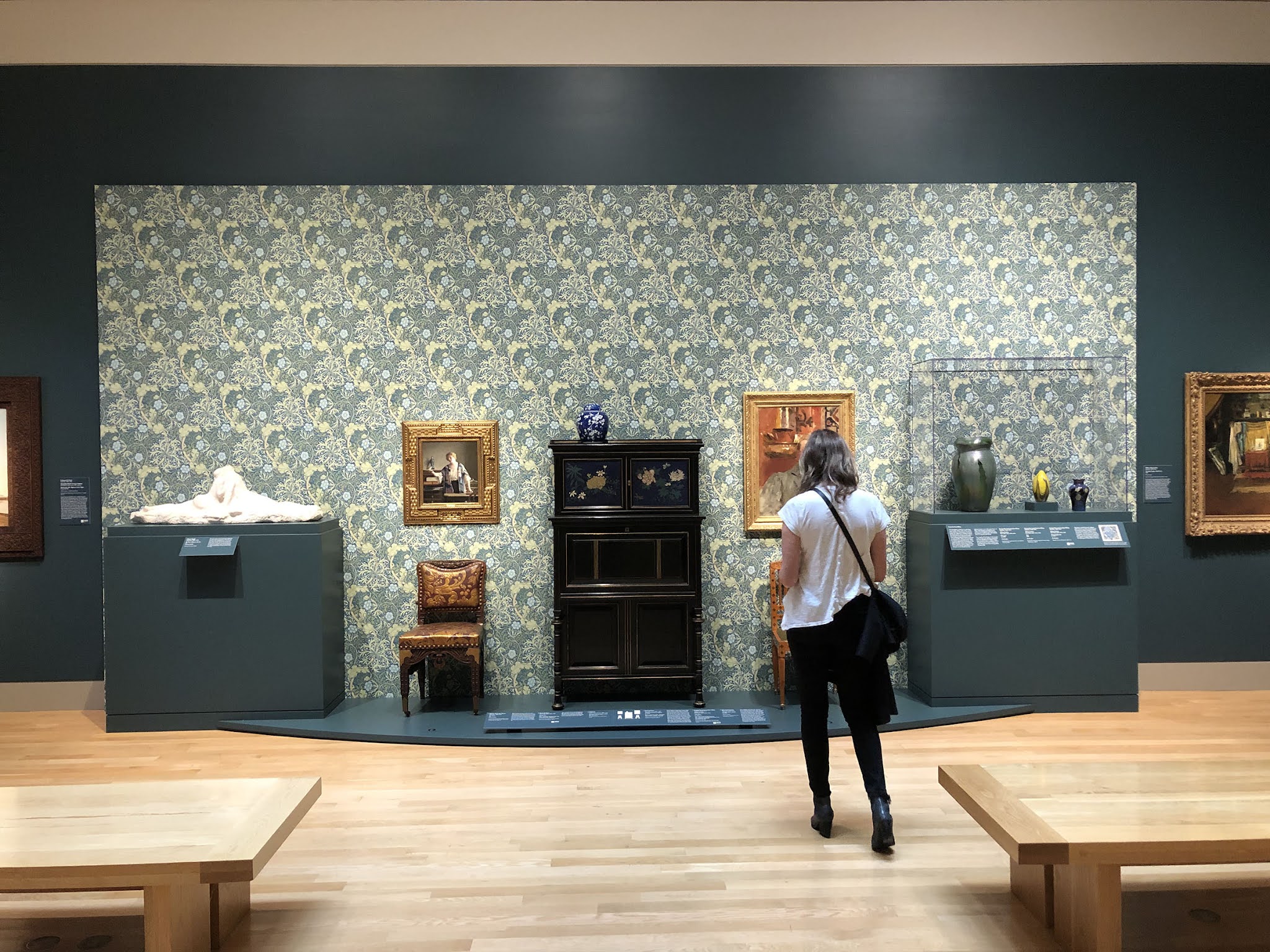 |
| Detail of Enrique Martínez Celaya, There-Bound, 2021 |
The Huntington has reopened about 5000 sf of its American galleries with an installation titled "Borderlands." Enrique Martínez Celaya has converted the Loggia and its borrowed view into something like a Picabia transparency. Sandy Rodriguez foregrounds Indigenous knowledge in a monumental map of Los Angeles. A darkened gallery shows Huntington-sponsored videos by the Bronx-based
Ghetto Film School. Takeaway #1 is that, yes, the Huntington is trying really hard to shed its reputation as the Whitest museum in L.A. #2 is that the collection and its displays are evolving, incrementally, in some interesting ways. The current installation of 19th- and 20th-century art has more Spanish surnames than you've ever seen at the Huntington before.
 |
| Installation of late 19th-century decorative art |
 |
| Sandy Rodriguez, YOU ARE HERE / Tovaangar / El Pueblo de Nuestra Señora la Reina de los Ángeles de Porciúncula / Los Angeles, 2021 |
 |
| Thomas Cole, Portage Falls on the Genesee, about 1839 |
The new Thomas Cole, acquired with a gift from the Ahmanson Foundation, anchors a room of American landscape painting from both sides of the border. Mega-collector Patricia Phelps de Cisneros has lent a small View of Tacubaya by José María Velasco, whose role in Mexican painting was comparable to Cole's. Unlike Cole, who drew on John Martin and German Romanticism, Velasco was more rigorously empirical, able to find poetry in rocks and chaparral.
 |
José María Velasco, View of Tacubaya, about 1895. Colección Patricia Phelps de Cisneros
|
 |
| Ferdinand Bellermann, Guácharo Cave, 1874. Colección Patricia Phelps de Cisneros |
The grandest Phelps de Cisneros loan is Guáchera Cave by Ferdinand Bellermann, a German artist who is best known for his views of Venezuela. As in the U.S., the hemisphere's natural wonders were considered an artistic subject rivaling the ruins and cathedrals of Europe. Bellermann rated the Guáchera Cave "more beautiful than any architecture."
The Andean volcano Chimborazo, subject of the Huntington's great Frederic Church painting, received similar praise. The Church is hung next to a painting (by Alexander-Francois Loemans) and a book illustration of the same peak.
With the Cole, the Huntington collection now includes most of the major Hudson River School figures save Albert Bierstadt and Jasper Francis Cropsey (and there's a small Bierstadt on loan).
 |
| Chester Beach, The River's Return to the Sea, 1906. Lent by Dr. James Zidell |
A room of late 19th-century art uses a William Morris wallpaper design as a backdrop for recently acquired works by the Herter Brothers and Lockwood de Forest. A sex-positive sculpture by Chester Beach, formerly owned by Gertrude Whitney, is a new loan.
Next door, Harriet Hosmer's Zenobia in Chains remains in her painted cube, but gallery texts now identify her as queer (as the artist did, more or less, in the language of her time). Sharing the space is a LACMA loan, Daniel in the Lion's Den, by African-American artist Henry Ossawa Tanner. Like Hosmer, Tanner found success as a European expatriate.
 |
| Harriet Goodhue Hosmer, Puck, after 1854 |
 |
| Salon-hang paintings with Chauncey Bradley Ives' Pandora, 1858 |
Most of the other rooms of the Virginia Steele Scott Galleries of American Art have reopened. There is now a salon-style hang of 19th-century painting. Winslow Homer's The Cotton Pickers, another LACMA loan, rates a wall to itself.
 |
| Miki Hayakawa, From My Window, 1935. Collection of Sandra and Bram Dijkstra |
Sandra and Bram Dijkstra have lent a Miki Hayakawa, From My Window. It shows a San Francisco skyline dominated by the newly built Coit Tower. Hayakawa was a Japanese immigrant who achieved considerable success in the pre-war milieu of Bay Area modernism. Internment interrupted her career, and her reputation never fully recovered (until recently). Another Hayakawa painting is featured in LACMA's new 20th-century installation.
 |
| Mabel Alvarez, Two Brothers, 1932. Lent by Dr. James Zidell |
Rounding out the roster of Spanish surnames is Mabel Alvarez, whose talented family included a Nobel-prize-winning physicist (Luis Alvarez, Mabel's nephew). She was shown at the Los Angeles County Museum as early as 1917 and had a one-woman show there in 1941.
The Huntington's new acquisition partnership with the Ahmanson Foundation has renewed speculation about where the collection goes from here. The new installation demonstrates that the Huntington is not limited to one big-money funder or lender. The Huntington's Art Collectors Council financed the Lockwood de Forest painting
Bank of the Nile, Opposite Cairo and partnered with the Virginia Steele Scott Foundation Acquisition Fund and three other supporters for
the Charles Bird King portrait of Moanahonga.
 |
| Enrique Martínez Celaya, There-Bound, 2021 |












Comments